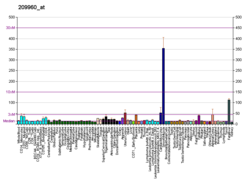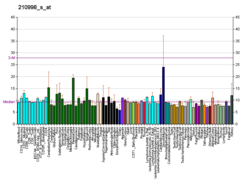Facteur de croissance des hépatocytes
Le facteur de croissance des hépatocytes (Hepatocyte growth factor, HGF) est un facteur de croissance, agent mitogène des hépatocytes (cellules du foie). Il se lie au récepteur tyrosine kinase c-met (MET)[5]. Son gène est le HGF situé sur le chromosome 7 humain[5].
Inhibiteurs[modifier | modifier le code]
Notes et références[modifier | modifier le code]
- GRCh38: Ensembl release 89: ENSG00000019991 - Ensembl, May 2017
- GRCm38: Ensembl release 89: ENSMUSG00000028864 - Ensembl, May 2017
- « Publications PubMed pour l'Homme », sur National Center for Biotechnology Information, U.S. National Library of Medicine
- « Publications PubMed pour la Souris », sur National Center for Biotechnology Information, U.S. National Library of Medicine
- (en) George K. Michalopoulos et Reza Zarnegar, « Hepatocyte growth factor », Hepatology, vol. 15, no 1, , p. 149–155 (DOI 10.1002/hep.1840150125, lire en ligne, consulté le )
Bibliographie[modifier | modifier le code]
- Michalopoulos GK, Zarnegar R, « Hepatocyte Growth Factor », Hepatology, vol. 15, no 1, , p. 149–54 (DOI 10.1002/hep.1840150125)
- Nakamura T, « Structure and function of hepatocyte growth factor », Prog. Growth Factor Res., vol. 3, no 1, , p. 67–85 (PMID 1838014, DOI 10.1016/0955-2235(91)90014-U)
- Ware LB, Matthay MA, « Keratinocyte and hepatocyte growth factors in the lung: roles in lung development, inflammation, and repair », Am. J. Physiol. Lung Cell Mol. Physiol., vol. 282, no 5, , L924–40 (PMID 11943656, DOI 10.1152/ajplung.00439.2001)
- Funakoshi H, Nakamura T, « Hepatocyte growth factor: from diagnosis to clinical applications », Clin. Chim. Acta, vol. 327, nos 1–2, , p. 1–23 (PMID 12482615, DOI 10.1016/S0009-8981(02)00302-9)
- Skibinski G, « The role of hepatocyte growth factor/c-met interactions in the immune system », Arch. Immunol. Ther. Exp. (Warsz.), vol. 51, no 5, , p. 277–82 (PMID 14626426)
- Kalluri R, Neilson EG, « Epithelial-mesenchymal transition and its implications for fibrosis », J. Clin. Invest., vol. 112, no 12, , p. 1776–84 (PMID 14679171, PMCID 297008, DOI 10.1172/JCI20530)
- Hurle RA, Davies G, Parr C, MD Mason, SA Jenkins, HG Kynaston et WG Jiang, « Hepatocyte growth factor/scatter factor and prostate cancer: a review », Histol. Histopathol., vol. 20, no 4, , p. 1339–49 (PMID 16136515)
- Kemp LE, Mulloy B, Gherardi E, « Signalling by HGF/SF and Met: the role of heparan sulphate co-receptors », Biochem. Soc. Trans., vol. 34, no Pt 3, , p. 414–7 (PMID 16709175, DOI 10.1042/BST0340414)
Liens externes[modifier | modifier le code]
- (en) MeSH Hepatocyte+growth+factor
- (en) Hepatocyte growth factor on the Atlas of Genetics and Oncology
- (en) UCSD Signaling Gateway Molecule Page on HGF








